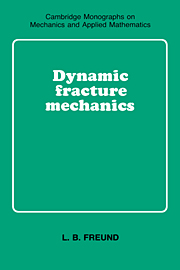Book contents
- Frontmatter
- Contents
- Preface
- List of symbols
- 1 Background and overview
- 2 Basic elastodynamic solutions for a stationary crack
- 3 Further results for a stationary crack
- 4 Asymptotic fields near a moving crack tip
- 5 Energy concepts in dynamic fracture
- 6 Elastic crack growth at constant speed
- 7 Elastic crack growth at nonuniform speed
- 8 Plasticity and rate effects during crack growth
- Bibliography
- Index
4 - Asymptotic fields near a moving crack tip
Published online by Cambridge University Press: 03 October 2009
- Frontmatter
- Contents
- Preface
- List of symbols
- 1 Background and overview
- 2 Basic elastodynamic solutions for a stationary crack
- 3 Further results for a stationary crack
- 4 Asymptotic fields near a moving crack tip
- 5 Energy concepts in dynamic fracture
- 6 Elastic crack growth at constant speed
- 7 Elastic crack growth at nonuniform speed
- 8 Plasticity and rate effects during crack growth
- Bibliography
- Index
Summary
Introduction
In Section 2.1, it was argued that the fields at an interior point on the edge of a stationary crack in an elastic solid are asymptotically two-dimensional. The convention of resolving the local deformation field into the in-plane opening mode (mode I), the in-plane shearing mode (mode II), and the antiplane shearing mode (mode III) was adopted. It was pointed out that the components of stress have an inverse square root dependence on normal distance from the crack edge and a characteristic variation with angular position around the edge. This variation is specified through the functions Σij(·) for each mode in Section 2.1. These general features are common to all configurations and all loading conditions. The influence of configuration and loading are included in the asymptotic description of stress only through scalar multipliers, one for each mode, which are the elastic stress intensity factors. The role of the stress intensity factor as a crack tip field characterizing parameter has been discussed in Sections 2.1 and 3.6.
The existence of similar universal fields for growing cracks is considered next. The same convention for categorizing local deformation modes will be followed. Except where noted explicitly to the contrary, the asymptotic crack tip fields will be determined for variable crack tip speed. Mode III will be considered first, because it is the simplest case to analyze, and the in-plane modes will be analyzed subsequently.
- Type
- Chapter
- Information
- Dynamic Fracture Mechanics , pp. 152 - 220Publisher: Cambridge University PressPrint publication year: 1990

